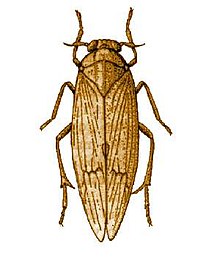Brown planthopper
| Nilaparvata lugens | |
|---|---|

| |
| Scientific classification | |
| Domain: | Eukaryota |
| Kingdom: | Animalia |
| Phylum: | Arthropoda |
| Class: | Insecta |
| Order: | Hemiptera |
| Suborder: | Auchenorrhyncha |
| Infraorder: | Fulgoromorpha |
| Family: | Delphacidae |
| Subfamily: | Delphacinae |
| Tribe: | Delphacini |
| Genus: | Nilaparvata |
| Species: | N. lugens
|
| Binomial name | |
| Nilaparvata lugens (Stål, 1854)
| |
The brown planthopper (BPH), Nilaparvata lugens (Stål) (Hemiptera: Delphacidae) is a planthopper species that feeds on rice plants (Oryza sativa L.). These insects are among the most important pests of rice, which is the major staple crop for about half the world's population.[1] They damage rice directly through feeding and also by transmitting two viruses, rice ragged stunt virus and rice grassy stunt virus. Up to 60% yield loss is common in susceptible rice cultivars attacked by the insect. The BPH is distributed throughout Australia, Bangladesh, Bhutan, Burma (Myanmar), Cambodia, China, Fiji, India,[2] Indonesia, Japan, North and South Korea, Laos, Malaysia, India, Nepal, Pakistan, Papua New Guinea, Philippines, Sri Lanka, Taiwan, Thailand, and Vietnam. Their alternative host plant other than rice is Leersia hexandra.
Biology
The brown planthopper is dimorphic, with fully winged 'macropterous' and truncate-winged 'brachypterous' forms. The macropterous forms are potentially migrants and are responsible for colonizing new fields. After settling on rice plants, they produce the next generation, where most of the female insects develop as brachypters and males as macropters. Adults usually mate on the day of emergence, and the females start laying eggs from the day following mating. Brachypterous females lay 300 to 350 eggs, whereas macropterous females lay fewer eggs. The eggs are thrust in a straight line generally along the mid-region of the leaf sheath. Eggs hatch in about six to nine days. The newly hatched nymphs are cottony white, and turn purple brown within an hour. They feed on plant sap. They pass through five instars before becoming adults.
Damage
BPH[3] infest the rice crop at all stages of plant growth. Due to feeding by both the nymphs and adults at the base of the tillers, plants turn yellow and dry up rapidly. During the early infestation stage, round yellow patches appear, which soon become brownish due to the drying up of the plants. This condition is called 'hopper burn'. Temperature is a critical factor that affects the life activities of this insect. The hatchability and survival rate are the highest around 25 °C. The eggs are highly sensitive to desiccation and soon shrivel when the host plant starts wilting. BPH population growth is maximal in a temperature range from 28 to 30 °C[citation needed].
Predators
Predators of this insect include the spiders Pardosa pseudoannulata and Araneus inustus.[4] In some cases, BPHs lay eggs in the rice seed beds (also known as rice nurseries) shortly before transplanting, so enter the field in this manner.[5]
Differential mortality of predators and hoppers does not appear to be the only factor for insecticide-induced resurgence.[6] Some insecticides evidently increase the protein content of BPH male accessory glands, and thereby increase planthopper fecundity.[7][8] Some insecticides increase the amount of amino acids and sucrose available in the phloem of rice plants, and thereby increase BPH survival.[9]
Management and control
Excessive use of
Rice varieties with resistance to BPH, e.g. IR64, are important for preventing outbreaks.[16][17][18] However, in areas with low insecticide use, high levels of BPH resistance are not usually necessary.[19] Chemical mutagenesis can significantly increase or decrease BPH resistance levels of rice.[20] Some chemical insecticides, e.g. imidacloprid, can affect the gene expression of rice and thereby increase susceptibility to BPH.[21]
In an attempt to make BPH control more species-specific, researchers are trying to develop methods of turning off specific BPH genes for digestion-, defense- and xenobiotic metabolism. Many novel genes for these functions have been detected in tissue from BPH intestines.[22]
Some plant lectins are antifeedants to BPH and if properly formulated may have the potential to protect rice from BPH.[23][24][25][26]
Impact of climate change
Research indicates that BPH nymphs are already living at the upper limits of tolerable temperatures. This suggests that climate warming in tropical regions with occasional extremely high temperatures would limit the survival and distribution of BPH.[27]
References
- PMID 10464789.
- ^ Oudhia, P. (2000). "Traditional medicinal knowledge about green leafhopper, Nephotettix spp., in Chhattisgarh (India)". International Rice Research Notes. 25 (3): 40.
- ^ "Brown plant hopper (BPH) | Rice Knowledge Management Portal - Rice,Paddy,Dhan,Chawal,Rice Research Domain, Rice Extension Domain, Rice Farmers Domain ,Rice General Domain, Rice Service Domain,RKMP,Rice in India,Rice Government Schemes, Rice ITKs, Rice FLDs, Rice Package of Practices". Archived from the original on 2016-03-04. Retrieved 2012-07-12.
- .
- .
- .
- .
- PMID 21800909.
- S2CID 55055863.
- ^ Preap, V.; Zalucki, M. P.; Jahn, G. C. (2006). "Brown planthopper outbreaks and management". Cambodian Journal of Agriculture. 7 (1): 17–25.
- ^ Preap, V.; Zalucki, M. P.; Jahn, G. C. (2002). "Effect of nitrogen fertilizer and host plant variety on fecundity and early instar survival of Nilaparvata lugens (Stål): immediate response". Proceedings of the 4th International Workshop on Inter-Country Forecasting System and Management for Planthopper in East Asia. November 13–15, 2002. Guilin China. Rural Development Administration / Food and Agriculture Organization. pp. 163–180.
- .
- ^ "IRRI supports Thai move to stop insecticide use in rice". Archived from the original on 2011-06-06. Retrieved 2011-06-03. IRRI media release: IRRI supports Thai move to stop insecticide use in rice.
- ^ action plan Archived May 1, 2012, at the Wayback Machine
- ^ international conference Archived May 1, 2012, at the Wayback Machine
- .
- S2CID 13088029.
- PMID 23434671.
- .
- S2CID 39941837.
- PMID 22544984.
- PMID 22361737.
- .
- .
- .
- PMID 9753773.
- PMID 22253720.
लाल mohamad
